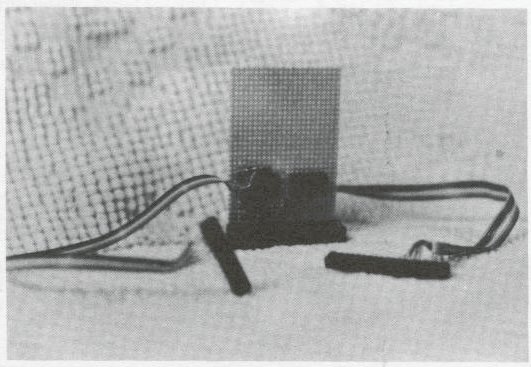For those who do not wish to go into their computer to connect a new keyboard, here is an interface which you can plug on to the rear expansion buss. You can easily add on one of those TI surplus keyboards which are selling for as low as five dollars.
This interface uses the same type of decoding as the ULA inside each of the computers and will work on all Sinclair computers, including the 2068 and the Spectrum. The interface is basically an input port which is scanned every so often to see if a key has been pressed. The way shown here does not buffer the address and data lines very well, so you will need to use short as possible wires running from the keyboard to the interface and be careful for shorts. I used eighteen inches’ on mine with no problem.
Adding dedicated keys is easy. Most will require that the caps or symbol shift be initiated (shift on the TS 1000) as well as the actual key with the function you are trying for. Following the keyboard layout diagram, We see that the caps shift on the 2068 and the shift key on the 1000 both make contact between A8 and KBDO. The symbol shift makes contact between A15 and KBD1.
Adding on the “extras” is easy, requiring the addition of two diodes. Some require the addition of a transistor and diode. It all depends on where the “extra” appears on the keyboard matrix. For example, the period on the 2068 resides at the intersection of A15 and KBD2 and requires the symbol shift to be pressed. Symbol shift is at the intersection of A15 and KBD1. A15 is shared by both keys’ and must make contact with both KBD1 and KBD2. The two diodes are added for isolation (see diagram for period) so that no shorts appear for the rest of the keyboard matrix.
Adding the comma on the TS 1000 will require contact between KBDO and A8 as well as contact between KBD1 and A15. To accomplish this, a separate Switching action must take place for KBD1 and A15 the 2N3904 transistor works fine for this task. When the key is pressed, KBDO and A8 make contact for the SHIFT operation and at the same time, the transistor is “turned on” to make contact between A115 and KBD1 to give the comma. See the diagrams to add some of the more popular functions.
The extra keys that I like to have are: DELETE, EDIT, period, comma, semi-colon, colon, asterisk, graphics, and EXTENDED mode (shifted FUNCTION on the 1000). Because they lie in the same position and require the same shift key, DELETE, EDIT, and GRAPHICS mode are obtained, the same way on both types of machines.
The keyboard matrix is just that – a matrix. In the diagram, wires running vertically and horizontally do not touch until a key is pressed. Each key has one set of two contacts so that the vertical lines go to one contact and the horizontal goes to the other. As said before, keep the wires short. To make them longer, you should buffer the address lines. While testing the four keyboards for our keyboard review, I was able to connect all the keyboards we had to the 2068 using this interface and had them all work well. So upgrade that computer of yours so your friends won’t come over and say “You do WHAT with that thing?”

